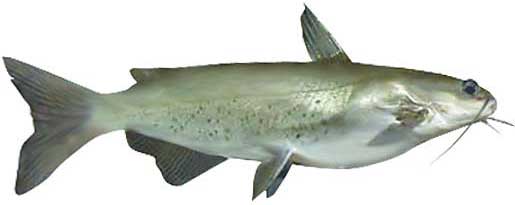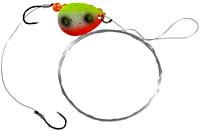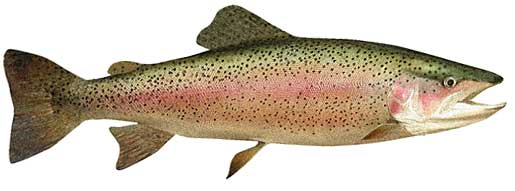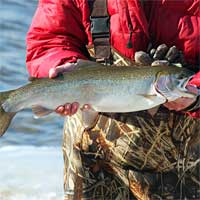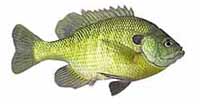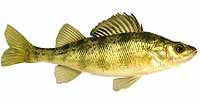Fishing Report For Lake Mary, AZ
By Rick Seaman
Last updated on .
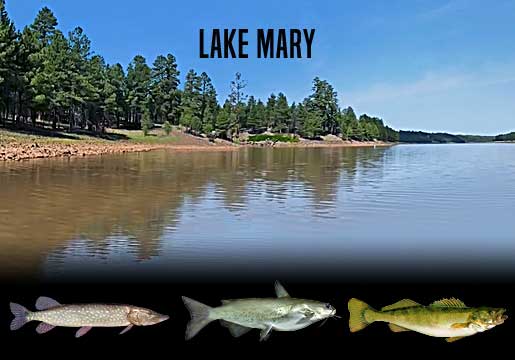
Fishing Reports
Popular Fish Species Lake Mary, AZ
Note that water levels can fluctuate radically, which may alter the depth of various species. Also, Lower Lake Mary often dries up during Summers with low precipitation.
Northern Pike
Current Report: Poor To Fair
FALL. Northern pike are a quite popular species here, and locals report catching them in decent quantity, along with an occasional big one. As the weather starts turning cold, water temperatures cool fastest in the shallows. This brings baitfish into shallower waters, and northerns follow along with this food source. They hang around weedbed edges, main-lake points, reefs, and rocky shorelines to ambush prey in 3 to 12 feet of water. This is a prime feeding time as they prepare for winter. It is also a good time to catch a trophy pike.
WINTER. Pike remain active in Winter, often congregating in or near remaining weedbeds, especially along the edges. Other structure options include flats with drop offs into deeper water. Ice fishing was good here in winter. At times, when oxygen is depleted in deeper water, northerns suspend directly under the ice, where maximum oxygen is available. Other times they hold on structure in 6 to 15 feet of water.
SPRING. After ice out, northern pike migrate to shallow, warmer pockets, bays and coves. Once water temperatures reach around 40 degrees, they move into even shallower areas with vegetation, to spawn. Ideal depths range from 2 to 10 feet. After spawning they linger in the shallows for a short period. Once water temperatures rise into the 50's, they move to slightly deeper weedbeds adjacent to even deeper water. Bright colors, whites, and flashy lures appeal to these predators. Noisy topwater lures can also produce some spectacular strikes. Alternate between baits until you identify which one triggers the most bites for the day.
SUMMER. Northern pike scatter all around the lake, rather than gather in groups. This makes them difficult to locate. During the day they are holding from 5 to 15 feet deep, on ledges, reefs, weedbeds, rock piles, islands and channel edges. Some of the larger specimens are suspending in open water, just outside feeding areas. Trolling or drift fishing produces some nice catches, using spoons, big spinners, cut bait, and deep diving crankbaits. Early and late in the day, they move shallow to feed and can be caught around most weedy shorelines, in 8 to 20 feet of water. Noisy topwater lures, spinnerbaits and Johnson spoons with curly-tail grubs, are catching nice pike shallow.
Channel Catfish

Current Report: Fair
FALL. Fall is one of the better times of year for catching channel catfish. Early in Fall they cruise the 4 to 12 feet deep shallows, in search of food. Later, in the season they migrate away from the shallows and current, to moderately deep flats and channel edges on the main body of the lake. They can typically be found from 6 to 15 feet deep. Fishing for channel catfish is often productive around any kind of structure. Road beds, creek channels and rocky points are all good places to begin. Drift fishing or slow-trolling baits along mid-depth structure is popular and generally productive. Use a slip sinker or Carolina rig setup. Use cut bait, nightcrawlers, shrimp or prepared baits. They remain in these areas and feed aggressively in preparation for Winter.
WINTER. In Winter, the channel cats gather in deep holes and go virtually dormant, especially if water cools into the 40's. They hole up in pockets, deeper channels, ledges, and the basin areas from 6 to 15 feet deep and await warmer water. Slow presentations, especially cut bait, can still entice strikes. Often during mid day, through the afternoon, anglers are catching them a bit shallower on the same structure.
SPRING. In Spring, when water temperatures rise into the high 40's, channel catfish start their migration into coves and up river. Early in the season, look for them in 4 to 12 feet of water. They hold here, and feed aggressively, around relatively shallow cover until water warms into the mid 70's, at which time they begin the spawn process. Anglers are using slip sinkers, 3-way rigs, or Carolina rigs to get, and keep, the bait close to the bottom. Later in Spring, focus on shallower flats into late evening.
SUMMER. In Summer, slow-moving water, at the river end of the lake may draw catfish to feed. Otherwise they are scattering, locating cover in slightly cooler water. Reports indicate the most successful anglers are using nightcrawlers, cut bait, minnows or shrimp. Most channel cats hold in 6 to 15 feet during the day, and 4 to 12 feet during the night. Fishing from late in the day until midnight produces some of the best results, as this is their prime feeding time.
Walleye
Current Report: Poor To Fair
A decent population of walleye are established in Lake Mary. They tend to concentrate around structure on points, flats and ledges off the river channels.
FALL. Fall brings cooler temperatures to shallow water, drawing walleye and baitfish shallower. A proven method for catching walleye here is trolling with spinners tipped with live bait, or trolling with long-billed, deep diving crankbaits. However casting live bait, jigs, worms and spoons also works well at times. Early Fall finds them in 10 to 20 feet of water. Later in Fall, they move out slightly deeper. Dragging jigs, bottom bouncers, or worm harnesses with nightcrawlers or leeches, around ledge drop-offs is catching walleye fairly consistently. Watch for the bigger walleye to be slightly deeper than the majority of the school.
WINTER. Winter fishing for walleye is tough. Before, and after the ice, anglers report catching them in 15 to 25 feet of water, along creek channel edges, rocky humps and ledges. They primarily feed on small fish, staying close to the bottom. After ice-out blade baits, jigs, swimbaits, spoons, deep-diving crankbaits, and worm harness spinners, all work while deep trolling or drifting.
SPRING. Early Spring brings warming water in the shallows, and draws walleye here to feed, especially rocky areas and inlet channels. In Spring work deep points, drop offs, submerged structure, rock ledges, deeper flats and edges adjacent to deeper water. Here, in 10 to 12 feet of water, they will spawn once the water warms to the mid to high 40's. When they move shallow, bright colored jigs, tipped with minnows or nightcrawlers typically catch them. Spinnerbaits, jerkbaits and crankbaits are also working when walleye are up shallow. Afterwards, they move to around 20 feet deep around points, flats, shoals and ledges, often staying in close proximity to their spawning locations.
SUMMER. Water temperatures rise in Summer, and walleye fishing is good if you can get your bait deep enough. Early in Summer, walleye tend to concentrate in 18 to 20 feet of water. Throughout Summer, early in the morning, and from dusk to long after dark are good times to catch walleye. At those times they move slightly shallower to feed in low-light conditions. Night fishing is often good in Summer, as well. The rest of the time they are cruising flats and creek channel edges, 20 to 25 feet deep , preferring the cooler temperatures. When the bite is slow, grubs and nightcrawlers, fished just off the bottom typically catch walleye.
Rainbow Trout
Current Report: Poor To Fair
Rainbow trout fishing at Lake Mary is popular with anglers of all ages and skill levels.
FALL. The lake is stocked with rainbow trout. Small spinners, worms or PowerBait all are popular baits here. Bring the kids and go rainbow trout fishing at Lake Mary and create lasting memories. Cooling water temperatures in the shallows, draw rainbow trout out of deeper Summer depths. Anglers are now catching them 15 to 20 feet deep on rocky banks, wind-blown points, rocky structure, humps, and anywhere baitfish are gathering. Now that they had a full summer to grow, there are some nice size rainbow to be caught. Small spinners, spoons, jigs, miniature crankbaits and swimbaits are good choices, as are salmon eggs and prepared baits. Later in Autumn, they move into 15 to 25 feet of water.
WINTER. When Winter sets in jigging spoons, and jigs tipped with bait, are catching rainbows out of 20 to 25 feet of water. These baits work well before, and after, ice covers portions of the lake. After ice out, deep trolling with leaded line or downriggers, or vertical jigging with spoons and jigs, are the best approach during the cold-water season.
SPRING. As water begins to warm in early Spring, rainbow trout move from their late winter holding areas to shallow, warmer water 10 to 20 feet deep. A good number of rainbows are typically caught from mid morning to late afternoon, during the warmest water of the day. Shallow flats and rocky structure are quick to warm in the afternoon sun. A wide variety of small spinners, spoons and bait are catching most of the fish.
SUMMER. Once Summer is here to stay, the warmer water drives rainbow deeper, 20 to 25 feet deep, occasionally deeper. Trolling with spoons, spinners and crankbaits, using downriggers or leaded line, and drift fishing with bait, are currently the most productive methods. Following drop-offs into deeper water, along structure or creek channels, is a major key to getting bites. Anglers fishing from the bank are using nightcrawlers or Berkley PowerBait, with heavy weights on a Carolina rig, to get baits into deeper water.
Fishing Video
Fish species to fish for...
Guide to fishing for largemouth bass, channel catfish, black crappie, walleye, rainbow trout, brown trout, bluegill, green sunfish, yellow bass, yellow perch and northern pike at Lake Mary in Arizona.
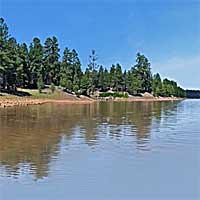 Lake Mary is actually two separate lakes - Upper and Lower Lake Mary. It is conveniently located 15 miles from Flagstaff, AZ. When full, Upper Lake Mary is a 600-acre lake. The upper lake is the primary fishery. According to the Forest Service, U.S. Department of Agriculture, "The lake has Northern Pike, Channel Catfish, Black Crappie, Walleye, Yellow Perch, and Yellow Bass." In Winter, whenever ice is safe, ice fishing is permitted.
Lake Mary is actually two separate lakes - Upper and Lower Lake Mary. It is conveniently located 15 miles from Flagstaff, AZ. When full, Upper Lake Mary is a 600-acre lake. The upper lake is the primary fishery. According to the Forest Service, U.S. Department of Agriculture, "The lake has Northern Pike, Channel Catfish, Black Crappie, Walleye, Yellow Perch, and Yellow Bass." In Winter, whenever ice is safe, ice fishing is permitted.
Primary fish species residing in Lake Mary
Click images for fishing tips and details about each species.
Today's Weather & Forecast
Fishing Boat Rentals
Click here for fishing boat rentals.
Marinas
Click here for marinas.
Boat Launch Ramps & Landings
Click here for boat ramps.
Fishing License
Click here for a Arizona Fishing License.
Map - Fishing & Access
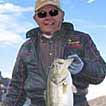 Rick Seaman is a fishing enthusiast with over five decades of fishing experience, a retired tournament fisherman, author of numerous published articles on fishing, and co-author of the book "Bass Fishing - It's not WHAT you throw, It's WHERE you throw it".
Rick Seaman is a fishing enthusiast with over five decades of fishing experience, a retired tournament fisherman, author of numerous published articles on fishing, and co-author of the book "Bass Fishing - It's not WHAT you throw, It's WHERE you throw it".
 Contact Information
Contact Information
Coconino National Forest
877 444-6777
Fishing lakes in each state
102225
Lake Mary, Arizona Report
ARIZONA



Information about fishing lakes in Arizona
Catch northern pike on topwater lures for some exciting fishing nearby Flagstaff, AZ.







